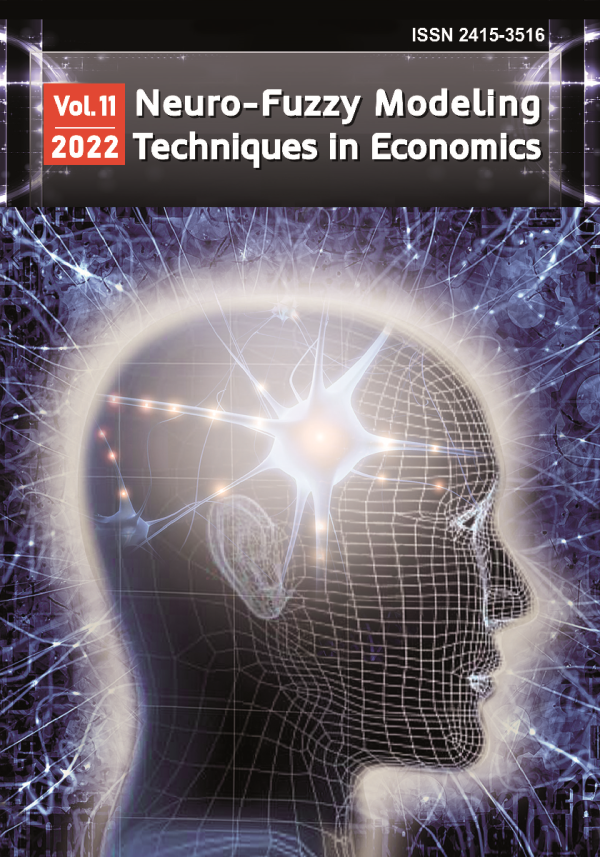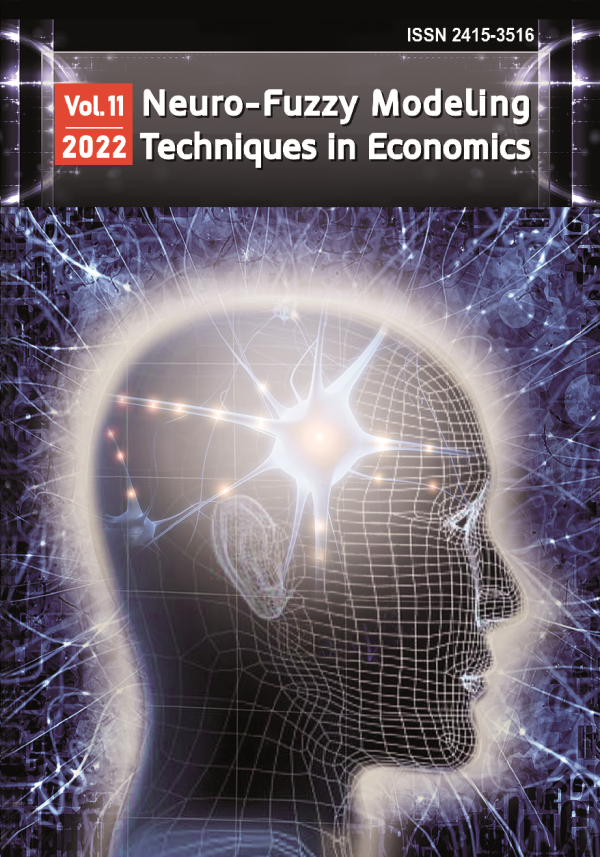
Neuro-Fuzzy Modeling Techniques in Economics
ISSN 2415-3516
Employment in the coordinates of digital economy: current trends and foresight trajectories
DOI:
10.33111/nfmte.2022.078
Анотація:
Abstract: The article presents a scientific and applied argumentation of current trends and the authors’ vision of foresight trajectories of employment in the coordinates of digital economy. A critical synthesis of existing scientific research has been carried out, which has shown the dynamic scaling of digital economy in global economic space with profound multi-vector shifts in employment at various levels.
The authors’ hypothesis that the scale and structure of employment would change intensively in both constructive and destructive dimensions under the influence of digitalization has been suggested and proved. The nature of constructivism and destructiveness of such changes has been disclosed.
Trends in the level of employment in global coordinates, in Europe as a whole and in Ukraine have been analyzed with the use of the International Labour Organization’s information resource.
It was clustered eight analyzed industries (in the field of high-tech manufacturing, high-tech services and certain export-oriented industries) using Kohonen self-organizing maps toolset, which allowed, based on a set of characteristic socio-labour and socio-economic indicators of the State Statistics Service of Ukraine for the period from 2013 to 2020, to analyze the state of development of each industry by the structure of employed and economic development, as well as to study trends in changes in state of industries in dynamics under conditions of digitalization.
The analysis of the clustering results showed that despite very serious economic challenges and real problems in most industries, 2014 and 2020 can be considered the years of rapid development of digital technologies in high-tech industries, which were accompanied by a reduction in the number of employees and a decrease in salaries. The least digital transformations mainly concerned industrial sectors during the years of economic recovery of Ukraine in the period from 2015 to 2018.
Results of the study of the impact of employment in high-tech industries and high-tech services sectors on the dynamics of gross domestic product and gross value added in the Ukrainian economy are presented. Results of forecasting these indicators with allocation of upper and lower confidence limits in a trend have been presented, which allowed to model optimistic, realistic and pessimistic scenarios of the abovementioned macroeconomic indicators development. A hypothesis regarding increase in the probability of implementing an optimistic scenario of gross domestic product and gross value-added dynamics under conditions of digitalization by optimizing the number and the structure of those employed in the high-tech segment has been proposed and proved.
Ключові слова:
Key words: world of work digitalization, destruction of employment, constructivism of transformations in employment, future of employment, human-centered sustainable development, economic sectors clustering, high-tech industries
УДК:
UDC:
JEL: C38 E24 J21 J23
To cite paper
In APA style
Kolot, A., Herasymenko, O., Shevchenko, A., & Ryabokon, I. (2022). Employment in the coordinates of digital economy: current trends and foresight trajectories. Neuro-Fuzzy Modeling Techniques in Economics, 11, 78-123. http://doi.org/10.33111/nfmte.2022.078
In MON style
Kolot A., Herasymenko O., Shevchenko A., Ryabokon I. Employment in the coordinates of digital economy: current trends and foresight trajectories. Нейро-нечіткі технології моделювання в економіці. 2022. № 11. С. 78-123. http://doi.org/10.33111/nfmte.2022.078 (дата звернення: 18.12.2025).
With transliteration
Kolot, A., Herasymenko, O., Shevchenko, A., Ryabokon, I. (2022) Employment in the coordinates of digital economy: current trends and foresight trajectories. Neuro-Fuzzy Modeling Techniques in Economics, no. 11. pp. 78-123. http://doi.org/10.33111/nfmte.2022.078 (accessed 18 Dec 2025).
 # 11 / 2022
# 11 / 2022
Download Paper

1154
Views
214
Downloads
4
Cited by
- Jia, Z., & Vattø, T. E. (2021). Predicting the path of labor supply responses when state dependence matters. Labour Economics, 71(C), Article 102004. https://doi.org/10.1016/j.labeco.2021.102004
- Van der Zwan, P., Hessels, J., & Rietveld, C.A. (2018). Self-employment and satisfaction with life, work, and leisure. Journal of Economic Psychology, 64, 73-88. https://doi.org/10.1016/j.joep.2017.12.001
- Cowling, M., Millán, J. M., & Yue, W. (2019). Two decades of European self-employment: Is the answer to who becomes self-employed different over time and countries? Journal of Business Venturing Insights, 12(C), Article e00138. https://doi.org/10.1016/j.jbvi.2019.e00138
- Nolan, A., & Barrett, A. (2019). The role of self-employment in Ireland’s older workforce. The Journal of the Economics of Ageing, 14(C), Article 100201. https://doi.org/10.1016/j.jeoa.2019.100201
- Patel, Pankaj C. & Wolfe, Marcus T. (2019). Money might not make you happy, but can happiness make you money? The value of leveraging subjective well-being to enhance financial well-being in self-employment. Journal of Business Venturing Insights, 12(C), Article e00134. https://doi.org/10.1016/j.jbvi.2019.e00134
- Stenard, B. S. (2019). Are transitions to self-employment beneficial? Journal of Business Venturing Insights, 12(C), Article e00131. https://doi.org/10.1016/j.jbvi.2019.e00131
- Lee, N., & Clarke, S. (2019). Do low-skilled workers gain from high-tech employment growth? High-technology multipliers, employment and wages in Britain. Research Policy, 48(9), Article 103803. https://doi.org/10.1016/j.respol.2019.05.012
- Sheehan, P., & Shi, H. (2019). Employment and Productivity Benefits of Enhanced Educational Outcomes: A Preliminary Modelling Approach. Journal of Adolescent Health, 65(1), 44-51. https://doi.org/10.1016/j.jadohealth.2019.03.025
- He, Y., Peng, X., & Xu, H. (2020). Overeducation, market recognition, and effective labour supply. China Economic Review, 59(C), Article 101384. https://doi.org/10.1016/j.chieco.2019.101384
- Kergroach, S. (2017). Industry 4.0: New Challenges and Opportunities for the Labour Market. Foresight and STI Governance, 11(4), 6–8. https://doi.org/10.17323/2500-2597.2017.4.6.8
- Wadley, D. (2021). Technology, Capital Substitution and Labor Dynamics: Global Workforce Disruption in the 21st Century? Futures, 132, Article 102802. https://doi.org/10.1016/j.futures.2021.102802
- Zhang, F., Meng, L., Sun, W., & Si, Y. (2021). Information technology and the labor market in China. Economic Analysis and Policy, 72(C), 156-168. https://doi.org/10.1016/j.eap.2021.06.015
- Giddens, A. (2002). Runaway World: How Globalization is Reshaping Our Lives. Profile Books.
- Rifkin, J. (1995). The end of work: The decline of the global labor force and the dawn of the post-market era. G. P. Putnam’s Son. http://pinguet.free.fr/rifkin1995.pdf
- Hines, A. (2019). Getting Ready for a Post-Work Future. Foresight and STI Governance, 13(1), 19–30. https://doi.org/10.17323/2500-2597.2019.1.19.30
- Kolot, A., & Herasymenko, O. (2017). Market, state and business in coordinates of the new economy. Problems and Perspectives in Management, 15(3), 76-97. http://dx.doi.org/10.21511/ppm.15(3).2017.07
- Kolot, A., Kozmenko, S., Herasymenko, O., & Štreimikienė, D. (2020). Development of a Decent Work Institute as a Social Quality Imperative: Lessons for Ukraine. Economics and Sociology, 13(2), 70-85. https://doi.org/10.14254/2071-789X.2020/13-2/5
- Kolot, A., Herasymenko, O., & Yarmolyuk-Kröck, К. (2020). Impact of COVID-19 pandemic on economic development and labor in Ukraine. Friedrich Ebert Stiftung. http://library.fes.de/pdf-files/bueros/kiew/17372.pdf
- Poruchnyk, A., Kolot, A., Mielcarek, P., Stoliarchuk, Y., & Ilnytskyy, D. (2021). Global economic crisis of 2020 and a new paradigm of countercyclical management. Problems and Perspectives in Management, 19(1), 397–415. https://doi.org/10.21511/ppm.19(1).2021.34
- OECD. (2015). Data-Driven Innovation: Big Data for Growth and Well-Being. OECD Publishing. http://dx.doi.org/10.1787/9789264229358-en
- Kenney, M., & Zysman, J. (2016). The Rise of the Platform Economy. Issues in Science and Technology, 32(3), 61-69. https://issues.org/rise-platform-economy-big-data-work/
- Fernández-Macías, E., Hurley, J., & Bisello, M. (2016). What do Europeans do at work? A task-based analysis: European Jobs Monitor. European Foundation for the Improvement of Living and Working Conditions. https://www.eurofound.europa.eu/publications/report/2016/what-do-europeans-do-at-work-a-task-based-analysis-european-jobs-monitor-2016
- Frey, C. B., & Osborne, M. A. (2017). The future of employment: How susceptible are jobs to computerisation? Technological Forecasting and Social Change, 114, 254–280. https://doi.org/10.1016/j.techfore.2016.08.019
- Huateng, M., Zhaoli, M., Deli, Y., & Hualei, W. (2021). The Chinese Digital Economy (G. Kaitian, & S. Xiao, Eds.). Palgrave Macmillan. https://doi.org/10.1007/978-981-33-6005-1
- Sorgner, A. (2017). The Automation of Jobs: A Threat for Employment or a Source of New Entrepreneurial Opportunities? Foresight and STI Governance, 11(3), 37–48. https://doi.org/10.17323/2500-2597.2017.3.37.48
- Seidl da Fonseca, R. (2017). The Future of Employment: Evaluating the Impact of STI Foresight Exercises. Foresight and STI Governance, 11(4), 9–22. https://doi.org/10.17323/1995-459X.2016.4.9.22
- Manyika, J., Chui, M, Miremadi, M., Bughin, J., George, K., Willmott, P., & Dewhurst, M. (2017, January 12). Harnessing automation for a future that works. McKinsey Global Institute. https://www.mckinsey.com/featured-insights/digital-disruption/harnessing-automation-for-a-future-that-works
- Fossen, F., & Sorgner, A. (2019). Mapping the Future of Occupations: Transformative and Destructive Effects of New Digital Technologies on Jobs. Foresight and STI Governance, 13(2), 10–18. https://doi.org/10.17323/2500-2597.2019.2.10.18
- Chang, J.-H., Rynhart, G., & Huynh, P. (2016). ASEAN in Transformation: The Future of Jobs at Risk of Automation. Bureau for Employers’ Activities. International Labour Organization. https://www.ilo.org/actemp/publications/WCMS_579554/lang--en/index.htm
- Reese, B. (2019, January 1). AI will create millions more jobs than it will destroy. Here’s how. Singularity Hub. https://singularityhub.com/2019/01/01/ai-will-create-millions-more-jobs-than-it-will-destroy-heres-how/
- Azmuk, N.A. (2019). Transformatsiia zainiatosti pry perekhodi do tsyfrovoi ekonomiky: hlobalni vyklyky ta stratehii adaptatsii [Transforming employment at the transition to the digital economy: global challenges and adaptation strategies]. Znannia. https://iie.org.ua/monografiyi/transformacija-zajnjatosti-pri-perehodi-do-cifrovoi-ekonomiki-globalni-vikliki-ta-strategii-adaptacii/ [in Ukrainian].
- Morrison, M. (2022, January 19). History of SMART Objectives. RapidBI. https://rapidbi.com/history-of-smart-objectives/
- Novikova, O., Zaloznova, Yu., Amosha, O., Khandii, O., Azmuk, N., Ostafiichuk, Ya., Shamileva, L., Pankova O., Novak, I., Shastun, A., Kasperovych, O., Ishchenko, O., Krasulina, Ya., Amelicheva, L., & Kompaniiets, V. (2022). Transformatsiia sotsialno-trudovoi sfery v umovakh tsyfrovizatsii ekonomiky [Transformation of the social and labor sphere in the conditions of digitalization of the economy]. NAN Ukrainy, In-t ekonomiky prom-sti. https://iie.org.ua/monografiyi/transformacija-socialno-trudovoi-sferi-v-umovah-cifrovizacii-ekonomiki/ [in Ukrainian]
- Kolot, A. M., & Herasymenko, O. O. (2021). Pratsia XXI: filosofiia zmin, vyklyky, vektory rozvytku [Work XXI: philosophy of change, challenges, vectors of development]. KNEU. https://ir.kneu.edu.ua/handle/2010/36870?show=full [in Ukrainian]
- International Labour Organization. (2019). Work for a brighter future – Global Commission on the Future of Work. https://www.ilo.org/wcmsp5/groups/public/---dgreports/---cabinet/documents/publication/wcms_662410.pdf
- Frey, C.B., Osborne, M. (2015). Technology at work: The future of innovation and employment. Citi Global Perspectives and Solutions. https://www.oxfordmartin.ox.ac.uk/downloads/reports/Citi_GPS_Technology_Work.pdf
- Manyika, J., Chui, M, Miremadi, M., Bughin, J., George, K., Willmott, P., & Dewhurst, M. (2017, January 12). A future that works: Automation, employment, and productivity. McKinsey Global Institute. https://www.mckinsey.com/featured-insights/digital-disruption/harnessing-automation-for-a-future-that-works/de-DE
- Organization for Economic Co-operation and Development. (2016). Policy Brief on the Future of Work – Automation and independent work in a digital economy. OECD Publishing. https://www.oecd.org/els/emp/Policy%20brief%20-%20Automation%20and%20Independent%20Work%20in%20a%20Digital%20Economy.pdf
- World Bank. (2016). World Development Report 2016: Digital dividends. https://doi.org/10.1596/978-1-4648-0671-1
- World Economic Forum. (2018). The Future of Jobs Report. https://www3.weforum.org/docs/WEF_Future_of_Jobs_2018.pdf
- United Nations, Department of Economic and Social Affairs, Population Division. (2017). World Population Prospects: The 2017 revision, key findings and advance tables (Working Paper No. ESA/P/WP/248). https://desapublications.un.org/publications/world-population-prospects-2017-revision
- International Labour Organization. (1991-2021). World Employment and Social Outlook Data Finder [Data set]. Retrieved July 10, 2022, from https://www.ilo.org/wesodata
- Kolot, A. M., & Herasymenko, O. O. (2019). Social and labor development in the XXI century: to the nature of global changes, new opportunities, limitations and challenges. Demography and social economy, 1(35), 97–125. [in Ukrainian]
- Kohonen, T. (2001). Self-Organizing Maps (3rd ed.). Springer.
- Kobets, V., & Novak, O. (2021). EU countries clustering for the state of food security using machine learning techniques. Neuro-Fuzzy Modeling Techniques in Economics, 10, 86-118. http://doi.org/10.33111/nfmte.2021.086
- State Statistics Service of Ukraine. (2013-2020). Statystychnyi zbirnyk «Pratsia Ukrainy» [Statistical collection “Labor of Ukraine”] [Data set]. Retrieved January 7, 2022, from https://www.ukrstat.gov.ua/druk/publicat/Arhiv_u/11/Arch_pu_zb.htm
- State Statistics Service of Ukraine. (2013-2020). Statystychnyi zbirnyk «Natsionalni rakhunky Ukrainy» [Statistical collection “National accounts of Ukraine”] [Data set]. Retrieved January 7, 2022, from https://www.ukrstat.gov.ua/druk/publicat/Arhiv_u/03/Arch_nr.htm
- State Statistics Service of Ukraine. (2013-2020). Tablytsia «vytraty-vypusk» Ukrainy u tsinakh spozhyvachiv [Ukraine’s consumption-output table at consumer prices] [Data set]. Retrieved January 7, 2022, from https://www.ukrstat.gov.ua/operativ/operativ2006/vvp/vitr_vip/vitr_u/arh_vitr_u.html

